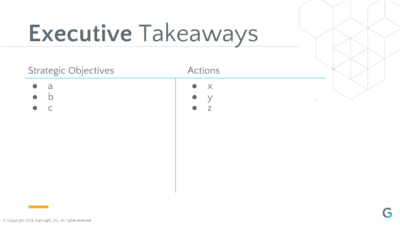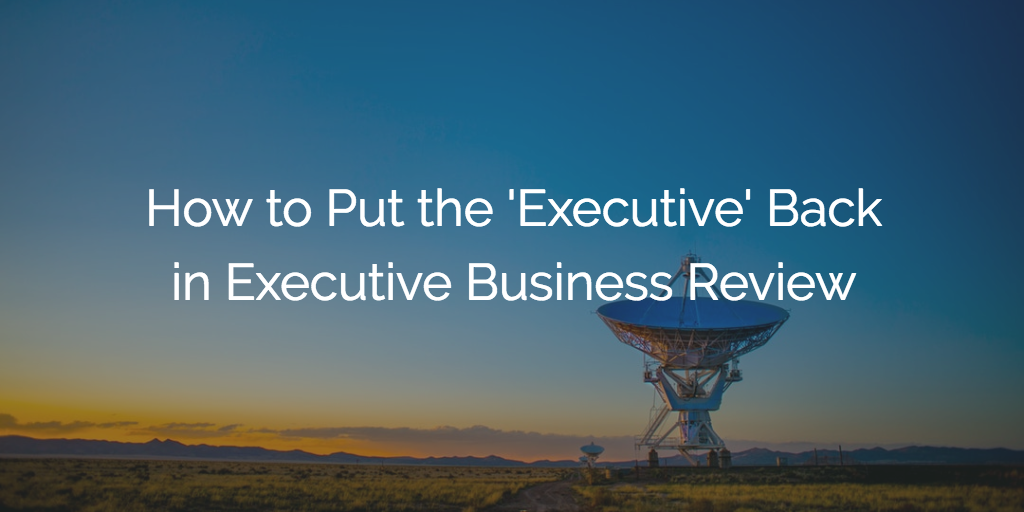If I had to make a list of the things that preoccupy my thoughts, I think Executive Business Reviews (EBRs) would probably come in fourth, behind my family, my company, and the Fermi Paradox.
And I think that’s true for three main reasons:
- As someone who loves (and values) meeting clients, I attend several Gainsight-to-client EBRs each week.
- As the CEO of a company that buys software, I occasionally attend vendor EBRs presented to us.
- As someone who lives in the “Customer Success Movement,” I get asked about EBRs all the time.
And so, as I was pondering the lack of evidence for intelligent alien life given the high number of Earth-like exoplanets alongside the strategic value of meeting with executive stakeholders at your clients, it hit me: EBRs have their own “Fermi Paradox.”
In case you’re not familiar with the Fermi Paradox, in a nutshell it’s this: given what we know about the number of habitable planets in the universe, where are all the aliens? And in what I’m dubbing “the EBR Paradox,” given what we know about the value of EBRs to both clients and vendors, where are all the executives?
Look around at the average EBR with your clients and identify the most senior title. If your top decision makers at your clients are attending consistently, you can skip this post. But if you—like us at Gainsight—want more senior engagement at your EBRs, read on!
How to Run a Progressive EBR
As an executive, I think part of the problem is that in most EBRs, CSMs and execs are speaking different languages. And because of that, execs will often choose to pass on EBRs. They believe (rightly or wrongly) they’re wasting their time.
We recently implemented a new sales and customer engagement methodology from a sales professional named Skip Miller, called ProActive Selling. In Skip’s book, he talks about the problem of language in business. A vendor (whether a sales rep or CSM) speaks using a certain level of “language” and the buyer is often thinking at a different level.
As he puts it, the classic problem is when a sales rep or CSM is talking “below the line” to an executive who is “above the line.”
Here’s an example:
CSM: “I’m excited to tell you about the new features in our latest release.”
Client CEO: “Awesome—let me pull in some of my team… You know what, they’ll be joining soon and I just got a call I have to take…”
I’ve seen EBRs (from Gainsight and elsewhere) that are sometimes like this. And I’ve seen ones done super-well. What’s the difference?
I’d like to introduce the concept of a “progressive EBR.”
This is inspired by the progressive dinner concept. Start at one friend’s house for appetizers. Then go to another friend’s for dinner. Finally, dessert at a third.
I propose you break the EBR into three similar “courses.”
Appetizer Course: Senior Executives + Working Team (First 30 Minutes)
I always laugh when a vendor invites me to a three-hour EBR. Honestly, I’d love to spend three hours going deep, but it’s really hard to imagine that’s the best use of my time. But if it’s important, I can always find 30 minutes.
So maybe you can get your client’s senior exec (and your own senior exec if they’re an executive sponsor) to the first 30 minutes.
If you do, time management is critical:
- Everything needs to be live and working before start time (dial-in, video, projector, Wi-Fi, etc.). I’ve seen so many exec meetings lose half their designated time to this!
- Start the meeting fast and with energy.
- Skip the self-intros. I saw one of our creative Client Outcomes Managers do the mass intro—she introduced everyone on the our side and one person from the client introduced everyone on the client side. 45 minutes of intros turned into two!
Now, what do you do with the 20 minutes or so (the executive miiight be late 😳) that you have left?
I imagine the following goals:
- Senior executive leaves feeling heard.
- Senior executive leaves feeling like the project is on track.
- Senior executive leaves feeling they need to do even more with the vendor.
Given those goals, you could consider the following tactics:
- Let the senior executive articulate the company’s strategic objectives related to the project (perhaps ask them to prep in advance). If the exec is like me, they love to talk!
- Have the project owner do an update (assuming it’s good) in front of the exec affirming the positive momentum.
- Have your most senior person on your side share news or momentum from your side of the partnership and challenge the exec with what more you could be doing together.
Main Course: Working Team Only (Two Hours)
This is where the typical (E)BR happens. Review releases. Talk about features. Discuss services. Rinse and repeat.
The Dessert: Working Team Aligns to ‘Trains’ (30 Minutes)
What if, though, we could then take the last 30 minutes to align the priorities defined by the senior executive in the first course to the actions we defined in the second? Skip Miller, in ProActive Selling, calls this “aligning to trains.” Every company has trains that are leaving the station—with or without your product. What if we could tie our product, adoption, and maturity to those initiatives the client has?
In many companies, I think this is often very disjointed. The executive lists priorities. The team comes up with activities. But the mapping is unclear. Vaguely, they’re all related to the goals, but the connection isn’t obvious.
Instead, what if you could close with a chart that shows the strategic objectives (“trains”) for the client on the left side (from the intro by the exec in the first course) and the actions/plans (from the second course) on the right?

Wouldn’t that be a great slide to send to the executive (from the first 30 minutes) right after the meeting?
Speaking for myself, that would be a HUGE incentive to lure me back next time.
We recently hosted a webinar on exactly this topic, in which our Sr. Manager of Strategic CS explains our approach to progressive EBRs. Incidentally, it’s one of our most popular webinars of all time! I encourage you to watch the recording and check out the slides.

